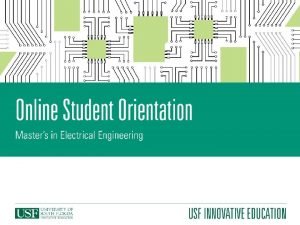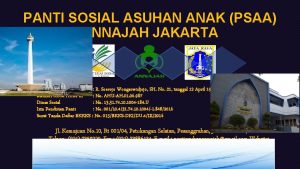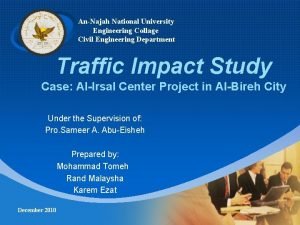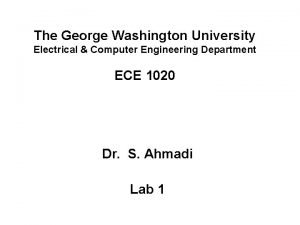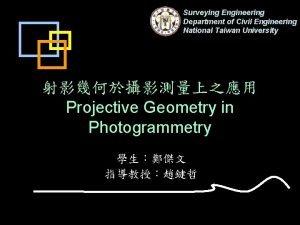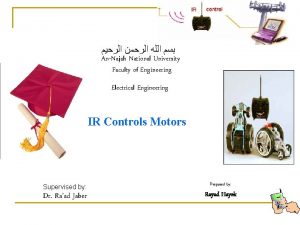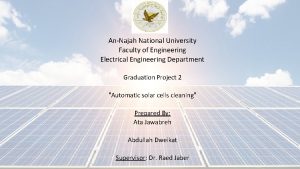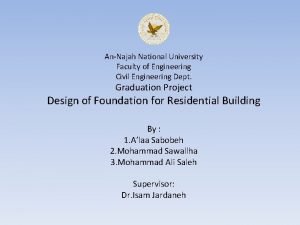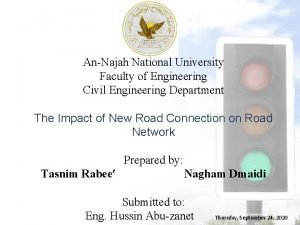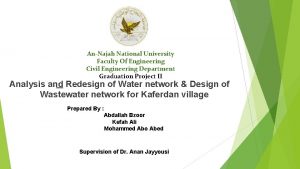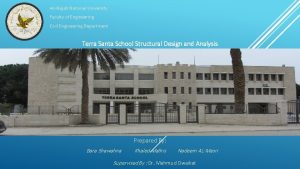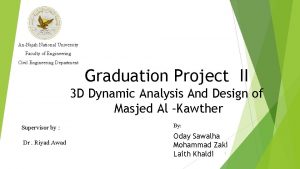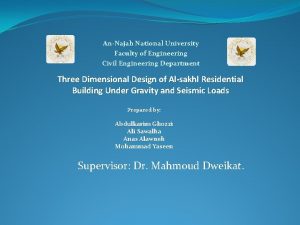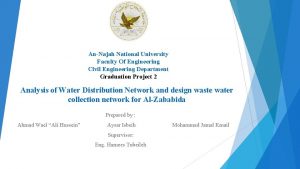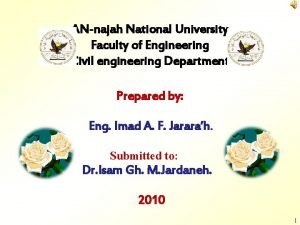AnNajah National University Faculty of engineering Electrical Engineering





























- Slides: 29

An_Najah National University Faculty of engineering Electrical Engineering Department Performance Analysis For Prepared by: Marwa Qadous Shereen Bader Supervisor Dr. Allam Mousa

Contents: Introduction. Application to noise cancellation. Adaptive filter. Estimation techniques. performance measures in adaptive systems Simulation results.

Introduction §Speech. §Background noise. § What is noise? § Noise that affects the speech signals; white noise, colored noise, and impulsive noise.

application to noise cancellation Headsets • people working near aircraft or in noisy factories can 0 wear these headsets to protect their hearing. Honda cars • a microphone connected to the car stereo system picks up all the sound inside the car. • produces noise-canceling sound waves that match the frequency of unwanted sound.

Adaptive Noise cancellation The purpose of adaptive noise cancellation is to improve the signal-to-noise ratio (SNR) of a signal by removing noise from the signal that we receive. the error signal will never become zero.

Adaptive Filter adaptive filter is a digital filter(FIR &IIR) combined with an adaptive algorithm, which is used to modify the coefficients of the filter variable Characteristics. The spectrum of a given signal overlaps with the noise spectrum. If the frequency band occupied by noise is unknown or may vary with time

Estimation Techniques LMS algorithm Characteristics q Simple and easy to implement. q Updates the coefficients sample by sample. q. Very hard to choose suitable parameters guarantees stability of the algorithm.

Algorithm: § Define the desired response. Set each coefficient weight to zero. § Calculate the output of the adaptive filter § Before the filter coefficients can be updated the error must be calculated § Update the filter coefficients § Then LMS algorithms calculate the cost function J (n) by using the following equation:

Normalized LMS v. It is a modified form of the standard LMS algorithm. v Weight function v. This step size can improve the convergence speed of the adaptive filter. v. Faster convergence than LMS comes at a price of greater residual error.

Recursive least squares (RLS) algorithms q. Use instantaneous value e 2 (n) and the past values. q. Update the filter coefficients q RLS algorithms calculate J (n) by using the following equation

Performance Measures in Adaptive Systems § Convergence Rate The rate at which the filter converges to its resultant state. §Minimum Mean Square Error Is a metric indicating how well a system can adapt to a given solution §Robustness The robustness of a system is directly related to the stability of a system. Robustness is a measure of how well the system can resist both input and quantization noise

§ Stability is probably the most important performance measure for the adaptive system the stability determined by the initial conditions, transfer function of the system and the step size of the input. § Computational Complexity Important in real time adaptive filter applications. § Filter Length specifies how accurately a given system can be modeled by the adaptive filter. It affects the convergence rate, stability of the system, and the minimum MSE

§signal-to-noise ratio The signal-to-noise ratio (SNR) provides a comparison of the amount of signal with the amount of background noise in a particular signal. § segmental signal-to-noise ratio

Simulation results Computational Complexity § The resources required to implement the LMS, NLMS, RLS algorithms The computations given are those required to process one sample MEMORY MULTIPLY ADD DIVIDE LMS NLMS RLS 0 2 L+7 L 2 +2 L+4 2 L + 1 2 L+4 2 L 2 +4 L 2 L 2 L+2 0 1 1. 5 L 2 +2. 5 L L

Analysis of Estimation Techniques Performance • Filter length effect LMS algorithm NLMS algorithm

RLS algorithm

• Step size effect: LMS algorithm

NLMS algorithm large mu NLMS algorithm small mu

• Convergence of the weights: LMS algorithm Effect of reducing mu on the weight

• Effect of changing Lambda RLS algorithm

• Effect of changing delta

Effects of changing language, speaker and gender on estimation techniques



SNR and noise power:

Output of the system Input signal: Noise Signal-plus-noise Filtered signal using LMS Filtered signal using NLMS Filtered signal using RLS

Summary § Effect of changing filter length, step size, lambd, delta on LMS, NLMS and RLS algorithms. § Effect of changing language, speaker and gender on estimation techniques. (SNR test) § Relation between SNR and noise power. § Listening test.


 Ece clemson
Ece clemson Usf electrical engineering faculty
Usf electrical engineering faculty Etfbl
Etfbl Studis.fe
Studis.fe Panti asuhan annajah
Panti asuhan annajah Logo annajah
Logo annajah Annajah motors
Annajah motors Annajah motors
Annajah motors Faculty of engineering university of porto
Faculty of engineering university of porto Lebanese university roumieh
Lebanese university roumieh Faculty of mechanical engineering thammasat university
Faculty of mechanical engineering thammasat university Tel aviv university electrical engineering
Tel aviv university electrical engineering University of belgrade school of electrical engineering
University of belgrade school of electrical engineering Gwu electrical engineering
Gwu electrical engineering Tel aviv university electrical engineering
Tel aviv university electrical engineering George washington university electrical engineering
George washington university electrical engineering National taiwan university civil engineering
National taiwan university civil engineering University of split faculty of maritime studies
University of split faculty of maritime studies University of bridgeport computer science
University of bridgeport computer science University of bridgeport engineering
University of bridgeport engineering Hubert kairuki memorial university faculty of medicine
Hubert kairuki memorial university faculty of medicine Semmelweis university faculty of medicine
Semmelweis university faculty of medicine Applied medical sciences
Applied medical sciences Florida state computer science
Florida state computer science Faculty of business and economics mendel university in brno
Faculty of business and economics mendel university in brno Singularity executive program
Singularity executive program Semmelweis university faculty of medicine
Semmelweis university faculty of medicine Ascaris lumbricoides ova
Ascaris lumbricoides ova Charles university humanities
Charles university humanities Faculty of veterinary medicine cairo university logo
Faculty of veterinary medicine cairo university logo

